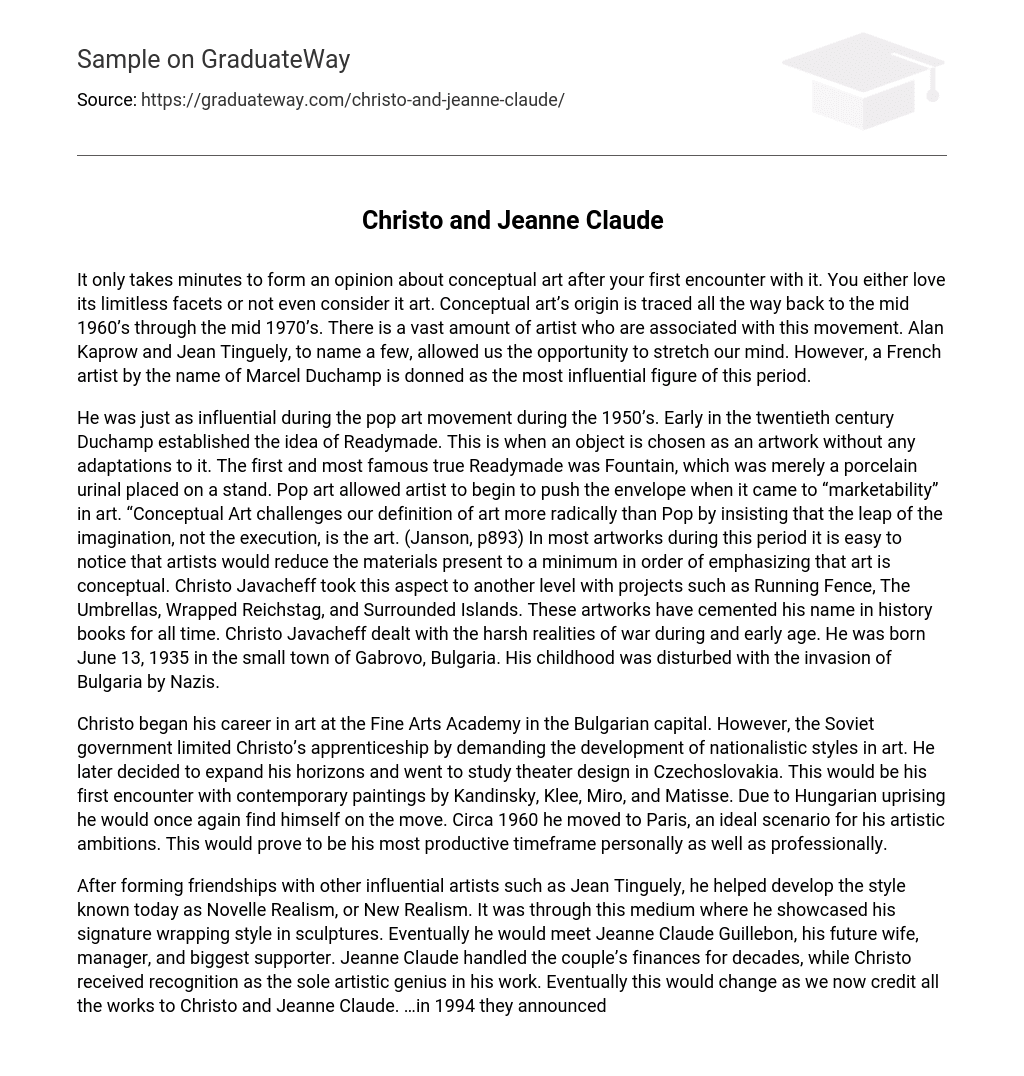It only takes minutes to form an opinion about conceptual art after your first encounter with it. You either love its limitless facets or not even consider it art. Conceptual art’s origin is traced all the way back to the mid 1960’s through the mid 1970’s. There is a vast amount of artist who are associated with this movement. Alan Kaprow and Jean Tinguely, to name a few, allowed us the opportunity to stretch our mind. However, a French artist by the name of Marcel Duchamp is donned as the most influential figure of this period.
He was just as influential during the pop art movement during the 1950’s. Early in the twentieth century Duchamp established the idea of Readymade. This is when an object is chosen as an artwork without any adaptations to it. The first and most famous true Readymade was Fountain, which was merely a porcelain urinal placed on a stand. Pop art allowed artist to begin to push the envelope when it came to “marketability” in art. “Conceptual Art challenges our definition of art more radically than Pop by insisting that the leap of the imagination, not the execution, is the art. (Janson, p893) In most artworks during this period it is easy to notice that artists would reduce the materials present to a minimum in order of emphasizing that art is conceptual. Christo Javacheff took this aspect to another level with projects such as Running Fence, The Umbrellas, Wrapped Reichstag, and Surrounded Islands. These artworks have cemented his name in history books for all time. Christo Javacheff dealt with the harsh realities of war during and early age. He was born June 13, 1935 in the small town of Gabrovo, Bulgaria. His childhood was disturbed with the invasion of Bulgaria by Nazis.
Christo began his career in art at the Fine Arts Academy in the Bulgarian capital. However, the Soviet government limited Christo’s apprenticeship by demanding the development of nationalistic styles in art. He later decided to expand his horizons and went to study theater design in Czechoslovakia. This would be his first encounter with contemporary paintings by Kandinsky, Klee, Miro, and Matisse. Due to Hungarian uprising he would once again find himself on the move. Circa 1960 he moved to Paris, an ideal scenario for his artistic ambitions. This would prove to be his most productive timeframe personally as well as professionally.
After forming friendships with other influential artists such as Jean Tinguely, he helped develop the style known today as Novelle Realism, or New Realism. It was through this medium where he showcased his signature wrapping style in sculptures. Eventually he would meet Jeanne Claude Guillebon, his future wife, manager, and biggest supporter. Jeanne Claude handled the couple’s finances for decades, while Christo received recognition as the sole artistic genius in his work. Eventually this would change as we now credit all the works to Christo and Jeanne Claude. …in 1994 they announced publicly that they were henceforth to be credited as a single artist. ”(Norton, p754) At first Christo experimented wrapping small objects such as bottles and cans. As he gained confidence he would increase the scale of his work. By the time he moved to New York in 1964 he was ready to take his artistic talent to unforeseen extremes. In 1968, he began an immense project wrapping the outside as well as the inside of the Museum of Contemporary Art in Chicago. 10,000 square feet of heavy tarpaulin and 4,000 feet of Manila rope were used on the outside of the building.
Precautions were taken to ensure public safety such as small openings being cut in the tarpaulin to keep the building’s air vents unobstructed. This distinguished style was repeatedly seen in Christo’s masterpieces such as Running Fence, Surrounded Islands, and Wrapped Reichstag, with each artwork never failing to add a new dimension. What is more remarkable is that not one of his monumental sculptures exists today. “They enhance the environment only temporarily instead of altering it permanently. ”(Janson, p888) Today conceptual art is appreciated for its pure form. It proclaims itself to be an art of the mind rather than the senses.
While stirring an array of emotions within anyone who laid eyes on his work, Christo also managed to unite people through his art. When creating Running Fence, the fence was not the work of art. The work of art is all the togetherness of landscape, materials, and the energy placed into the artwork by all the people involved in the actual process: 300 students, 2,050 posts, 165,000 yards of material, and miles of wire and hundreds of thousands of hooks. “Since 1972, when Christ conceived the project, it has cost him 2,250,000- raised by selling off his drawings and project studies to European collectors…..
If they tear it down immediately afterward, that’s all right. That’s all part of the function of a fence. That’s process art in action, with a coastal commission and a supreme court as sculptures. ” (Time, 108)
Works cited
“Christo: Plain And Fency. ” Time 108. 12 (1976): 104. Academic Search Complete. Web. 9 Nov. 2012. Janson, Anthony F. “History of Art. 6th Edition. Harry N. Abrams, Inc. (2001) Norton, Anne Belle Wilder. “Site-Specific Art Gets A Bum Wrap: Illustrating The Limitations Of The Visual Artists Rights Act Of 1990 Through A Study Of Christo And Jeanne-Claude’s Unique Art. ” Cumberland Law Review 39. 3 (2008): 749-784.





